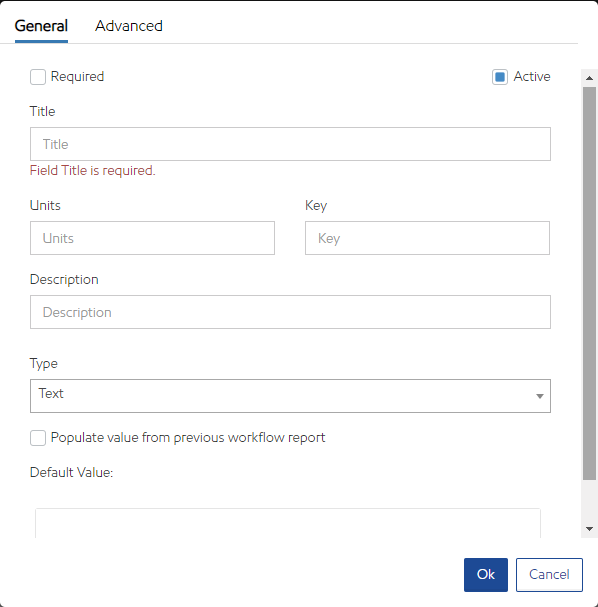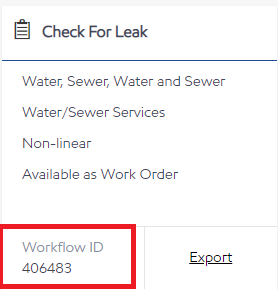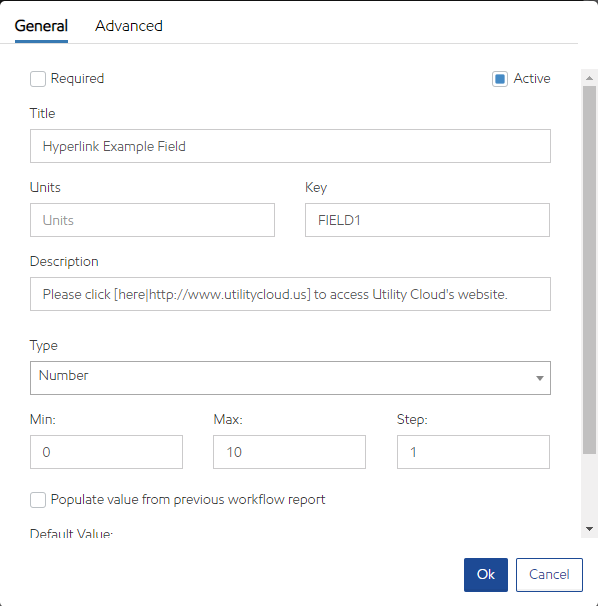Asset class attributes and workflow fields
Steps to Creating Asset Class Attributes and Workflow Fields


- Select the Asset Classes or Workflow Classes tile from the Landing Page or from the left navigation menu.
- Select the desired search criteria to find the specific asset or workflow class.
- Select the asset or workflow class to access the Editor screen.
- To create a new field, select "No fields have been defined. Click here to add one." if no fields have been defined or the plus icon.
- Enter all required fields for your asset attribute or workflow field.
- Select Save to save changes made to your attributes or fields.
The right side of the screen allows the user to create fields. The left side of the screen displays a preview of what the list of fields will look and behave like to the end user.

Video - Asset Class Attributes
Security Rights Required: View Asset Classes; Edit Asset Classes; OR View Workflows; Edit Workflow
General Settings
- Required: Identifies if the user must provide a value in this field.
- Active: Used to activate/deactivate a field. Fields are not able to be deleted to maintain historical information.
- Title: The name of the field which is displayed to the user.
- Units: Used to identify the unit such as feet, inches, gallons, etc.
- Key: This is a unique identifier. It is used as a reference in expressions as well as conditional visibility or conditional popup messages.
- Description: Used for any additional information a user may need to know about the particular field. This will appear as informational text below the specified field.
- Type: See the Field Types section below
- Populate value from previous workflow report: Checking this checkbox will automatically populate the value from the same field from the previous workflow completed.
- Default Value: The Default Value is used to automatically enter data in the field when the asset is created. The user may modify this value if it is incorrect for the particular asset.
NOTE: When defaulting to the value of another field in the same workflow the syntax varies depending on the type of field.
Number fields: =KEY
Multiple Choice fields: [KEY]
Advanced Settings
- Use String Literal For Reports: This is used for reporting when a field must return a string value.
- Visibility is Conditional: Check this box if you want to make the field show or hide based on certain conditions.
- To define conditional visibility based on a single value:
- Show when: KEY=Value (example: FLOW=Yes) no quotes
- To define conditional visibility based on multiple values:
- Show When Key=1~Key=2~Key=3
- To define conditional visibility based on a range of values:
- Show When: Key1<Key2 or Show When: Key1>10
- (Key Field): (=, <, >,!=, >=, <=, contains, does not contain)
- To determine if a Multi Select type field contains a specific value:
- KEY contains VALUE (example: COLOR contains Green)
- To determine if a Multi Choice type field contains a specific value:
- KEY=VALUE (example: COLOR=Green)
- To define conditional visibility based on a single value:
NOTE 2: HIDE when TRUE visibility conditionals will also hide the default value field for multiple choice, multiple select, and true/false fields.
Setting visibility conditional to HIDE when TRUE will always hide a field, preventing a user from seeing or editing it. This is typically only used for expressions.
- Show Conditional Popup Message: Check this box if you want to make a popup message appear based on certain conditions. These conditionals are defined the same as the visibility conditionals above.
Field Types
Select one of the available field types (each is described in further detail below):
Additional Report Emails
Form fields using the Additional Report Emails type allow users to select an email address to send a report to the desired party. To have the additional report emails form field send an email of the completed work report, the workflow must have a report associated with the work. To associate a report to the workflow the user will have to configure the workflow for reporting on the Workflow Class Builder page. There the user will add the appropriate google sheet to send the workflow data to create the report.
This form field type allows users to streamline their operations by allowing users the ability to email their clients immediately after the work is completed. This bypasses the process of completing the work, downloading the report, and then sending the report via email in separate steps. When constructing the Workflow form fields, users can add as many Additional Report Emails form fields to ensure all necessary parties are notified and receive the report promptly.
Assets
Assets fields let a user select from a list of assets related to the current asset. Asset fields will display either all assets that are children of the current asset, all assets in the same account as the current asset, or all assets that are both in the same account as the current asset and that asset's children. These asset fields can be used in conjunction with triggers to determine which asset will receive an update in an update other asset attribute trigger or which will have a work order created against it in a dynamic work order trigger.
Date
Select Date to validate values are entered in MM/DD/YYYY format. The user will be able to select the date from the calendar. A Default Value may be set for this data type, along with date range validation.
The Default Value entered will automatically appear for this field when the asset is created. The user may modify this value if it is incorrect for the particular asset.
- Enter a specific date to default into this field when a new asset or workflow is created.
- Enter T to automatically populate the Current date.
- Enter T+# to have the current date plus the specified number of days automatically populated.
- Enter T-# to have the current date minus the specified number of days automatically populate.
The Default Value field also allows for the validation of date entries. If the value entered for this field on the asset/workflow does not meet the specified conditions, the user will see the message Invalid Date. Supported validations include: >=T, <=T, >T,<T. To add validation, the default value and the validating condition should be separated by a comma. For example, to default today’s date and also validate that the date is equal to or less than today’s date, enter one of the following into the default field: T,<T+1 or T,<=T.
Datetime
Select Datetime to validate values are entered with both date and time in the field. Datetime type fields require values to be entered in MM/DD/YYYY HH: MM – AM or PM format. A Default Value may be set for this data type.
The Default Value entered will automatically appear for this field when the asset is created. The user may modify this value if it is incorrect for the particular asset.
- Enter a specific Datetime to default into this field when a new asset or workflow is created.
- Enter N to automatically populate both the current date and time.
Select Email to validate values are entered in the email address format.
Expression
Expressions are used to make calculations based on values entered in Utility Cloud, more often on workflows. These values can be from the same or different workflows. Expressions rely on keys and IDs to reference the appropriate value or ID necessary to build the formula.
A few rules:
- Brackets define Keys and Field IDs from within the same workflow
- Braces define the Keys from a previous or otherwise defined workflow
- Parentheses define the order of operations
- Keywords include previous, workflow, asset id, attributes, hours, days, etc...
Workflow Keys can be found on the Workflow Classes tile when searching from the search results screen or from the main Edit panel on the Workflow Class Builder page.

Frequently used expressions:
| Goal | Calculation | Notes |
|---|---|---|
| Calculate the difference between two dates | ([HSTot])-previous({HSTot}) | HSTot is the defined Key in the workflow above representing the HS Totalizer reading |
Pull a value from one workflow, on another asset, into the current workflow | workflow(WFID, AssetKey, WFFID) | (workflow id, asset key, workflow form field id or key) Example: workflow(5880, 3377854, 37494) |
| Pull a value from the asset into a workflow | [Asset. Key] | [Asset. Color] |
| Control amount of decimal places fixed | fixed([HSTot])-previous({HSTot},2) | "fixed" in the front of the expression and ",2" at the end of the expression rounds it to 2 decimal places. |
| Multiply the value to perform calculations | fixed([44178])*2 | 44178 is the work flow form field id |
| Display the number of days between inspections days | days([DOI],previous({DOI})) | DOI is the field key |
| Calculate the difference between two times in minutes | fixed(hours([FLUSHEND],[FLUSHSTART])*60, 0) | FLUSHSTART and FLUSHEND are TIME type fields |
| Calculate the difference between two dates in days | fixed(days([STARTDATE],[ENDDATE]),2) | STARTDATE and ENDDATE are DATE type fields |
| Calculate the difference between two dates in months | fixed(months([STARTDATE],[ENDDATE]),2) | STARTDATE and ENDDATE are DATE type fields |
| Calculate the difference between two dates in years | fixed(years([STARTDATE],[ENDDATE]),2) | STARTDATE and ENDDATE are DATE type fields |
| Calculate volume in Liters from Diameter in inches and length in ft | fixed((([Diameter of Pipe]/24)*([Diameter of Pipe]/24) )*([Length])*(88.912),2) | Where Diameter of Pipe is key on field in workflow, Length is key in workflow, the "fixed" and ",2" at the ends of the expression rounds it to the hundredth's place. |
| Pull the current Work Order ID onto the workflow report: | {WorkOrderID} | |
| Compare values in 2 different fields and return a different value - OR | ([CapUsed]>25||[CapUsed2]>25? "FAIL":"PASS") | If the value in CapUsed is greater than 25 OR the value in CapUsed2 is greater than 25 then return FAIL. Otherwise, return PASS. |
| Compare values in 2 different fields and return a different value - AND | ([CapUsed]>25&&[CapUsed2]>25? "FAIL":"PASS") | If the value in CapUsed is greater than 25 AND the value in CapUsed2 is greater than 25 then return FAIL. Otherwise, return PASS. |
| Concatenate several text type fields together | [Fieldname1] + [Fieldname2] + [Fieldname3] | Example: Fieldname1 = "ABC", Fieldname2 = "123", Fieldname3 = "XYZ" the result would be "ABC123XYZ" |
| Concatenate several number type fields together | [Fieldname1] + "" + [Fieldname2] + "" + [Fieldname3] | An empty string in between will prevent the field values from being added together. Example: Fieldname1 = 123, Fieldname2 = 444, Fieldname3 = 999 the result would be 123444999 |
| Display a value based on if the value of another field is equal to/not equal to a defined value. | [KEY] == value ? value to display if true : value to display if false | Single option: [TYPE]=="CB"?[CBAssetID]:"Nothing" If the value of the TYPE KEY = "CB" then display the value of the CBAssetID KEY field, otherwise display the word "Nothing" Multiple options: [TYPE]=="CB"?[CBAssetID]:[TYPE]=="DMH"?[DMHAssetID]:[TYPE]=="Outfall"?[OutAssetID]:[TYPE]=="Culvert Inlet"?[CulAssetID]:"Nothing" If the value of the [TYPE] KEY = "CB" then display the value of the CBAssetID KEY field, otherwise if the value of the [TYPE] KEY = "DMH" then display the value of the DMHAssetID KEY field, otherwise if the value of the [TYPE] KEY = "Outfall" then display the value of the OutAssetID KEY field, otherwise if the value of the [TYPE] KEY = "Culvert Inlet" then display the value of the CulAssetID KEY field, otherwise display the word "Nothing" |
| Display a value based on if the value of another field contains a defined value. | contains([KEY], "value") ? "value to display as true" : "value to display if false" | contains([KEY], "Value 1") ? "Value 1 is contained in the field KEY" : "Value 1 is not contained in the field KEY" If any part of the value identified is part of what is entered for the KEY field, then the true value will show. This is particularly useful for identifying a single value selected as part of a multiple select field. |
Pass a value from a triggering workflow to the triggered work order. | trigger(Workflow Field ID) | If you have a workflow set to trigger another work order, you would use this expression on the triggered workflow to pull the field value from the triggering workflow into the triggered one. Example: trigger(50875949) |
| Pass the workflow report ID of the triggering work to the triggered work order. | {TriggeringReport} | If you have a workflow set to trigger another work order, you would use this expression on the triggered workflow to pull the workflow report ID from the triggering workflow into the triggered one. |
Heading
Select Heading to enter titles to separate sections of the asset.
Memo
Select Memo for a longer free entry field across multiple lines.
Multiple Choice
Select Multiple Choice to allow for a selection from a dropdown list. The lists displayed in the dropdown come from the List Definitions. If the desired list is not an available selection the user may create the list from this screen. For more information about Lists see List definitions.
Multiple Select
Select Multiple Select to allow for multiple selections from a dropdown list. The lists displayed in the dropdown come from the List Definitions. If the desired list is not an available selection the user may create the list from this screen. For more information about Lists see List definitions.
Number
Select Number to validate numeric values are entered. Fields using the Number type require numeric values. The user will be required to enter a valid range for the field:
- Min: the minimum allowable value
- Max: the maximum allowable value
- Step: allowable increments (decimals/whole numbers)
If the value entered for this field on the asset does not meet the specified conditions, the user will see a message indicating the value is invalid.
To populate the Min/Max/Step fields based on a value from another field in the workflow enter =KEY as the default value.

Photo
Select Photo to allow the user to upload a photo for each asset.
QR Code
Select QR Code to allow the user to associate the asset with a QR code for easy identification.
Signature
Select Signature to allow the user to sign their name to a field.
Telephone
Select Telephone to validate values are entered in the format of ###-###-####. A 10-digit numeric value is required.
Text
Select Text for a free entry field including letters, numbers, and any punctuation, when the entry is relatively small.
Time
Select Time to validate values are entered in HH:MM – AM or PM format. A Default Value may be set for this data type. The Default Value entered will automatically appear for this field when the asset is created. The user may modify this value if it is incorrect for the particular asset.
True/False
Select True/False to display a checkbox for the user when entering information for the asset.
Users
Allows for the selection of one or more users in Utility Cloud.
Re-Arranging Fields
Fields can be re-arranged by selecting the field and dragging it up or down.
Hyperlinks
Hyperlinks can be provided using either the Description of the asset class attribute/workflow field of any data type or the Default Value field of a Text Type field.
To display text as a hyperlink enter [title|url] in the entry:
Please click [here|http://www.utilitycloud.us] to access Utility Cloud's website.
Description Hyperlink: If the Hyperlink is added as the Description, it will appear as informational text below the specified field title.


Default Value Hyperlink: If the Hyperlink is added as the Default Value, it will automatically appear for this field when the asset is created. The user may modify this value if it is incorrect for the particular asset.
